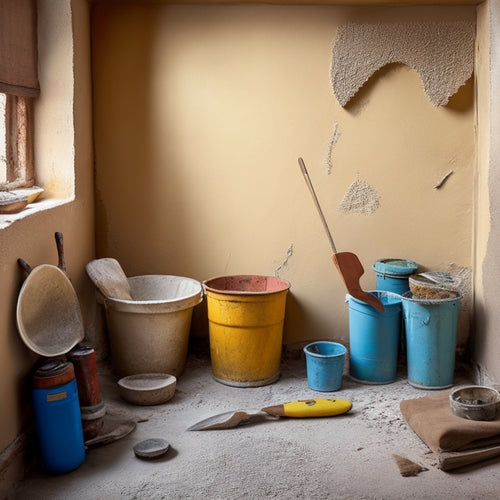
What to Inspect in Your Renovation Tool Kit
Share
When inspecting your renovation tool kit, you'll want to start with the concrete mixer, checking the drum, blades, and motor for wear, corrosion, or damage, as well as evaluating its portability and fuel efficiency. Next, inspect the drum and blades for rust, corrosion, or damage, and assess the electrical and hydraulic systems for signs of wear, corrosion, or overheating. Don't forget to examine safety features like goggles, tool belts, and gloves, as well as cleaning and maintenance tools like soft-bristled brushes and compressed air. By taking these first steps, you'll be well on your way to identifying potential issues before they become major problems - and there's even more to explore to guarantee your tool kit is running at its best.
Key Takeaways
• Inspect your concrete mixer's drum, blades, and motor for wear, corrosion, or damage to ensure optimal performance and longevity.
• Examine electrical connections and wiring for damage or corrosion to prevent electrical shocks and fires.
• Check safety goggles, tool belts, gloves, and steel-toed boots for proper fit and condition to prevent accidents and injuries.
• Verify hydraulic fluid levels and inspect the system for leaks, cracks, or damage to ensure efficient and safe operation.
• Establish a regular maintenance schedule to inspect and clean tools, identifying potential issues before they escalate.
Concrete Mixer Condition
Check your concrete mixer's condition by inspecting its drum, blades, and motor for signs of wear, corrosion, or damage that could compromise its performance or safety.
You'll want to guarantee that your mixer is in top shape to get the job done efficiently and safely.
Consider the mixer's portability - is it easy to move around the job site? Are the wheels or handles damaged, making it difficult to transport?
Also, check the fuel efficiency of your mixer. A well-maintained mixer won't only save you time but also reduce fuel costs. Look for any signs of fuel leaks or worn-out spark plugs that could affect the mixer's performance.
Additionally, inspect the electrical connections and wiring for any damage or corrosion.
By conducting a thorough inspection, you'll be able to identify any potential issues and address them before they become major problems.
This will help you avoid downtime, reduce repair costs, and guarantee a safe working environment.
Drum and Blade Inspection
As you've confirmed your concrete mixer's overall condition is satisfactory, now focus on the drum and blades, the heart of the mixer, where signs of wear, rust, or damage can greatly impact mixing efficiency and quality.
Drum wear can lead to uneven mixing, while dull blades won't properly break down materials, resulting in subpar concrete.
To inspect the drum, look for signs of rust, corrosion, or excessive wear on the interior and exterior surfaces. Check for any cracks, dents, or scoring that could compromise the drum's integrity. You should also inspect the drum's sealing system, verifying it's free from damage or wear that could lead to material leakage.
Next, examine the blades for sharpness and damage. Dull or damaged blades can't effectively mix materials, leading to poor concrete quality. Check for signs of wear, rust, or corrosion on the blades and their mounting systems. Confirm the blades are securely attached to the drum and properly aligned for best mixing performance.
Electrical and Hydraulic Systems
You'll need to examine the electrical and hydraulic systems, the nerve center of your concrete mixer, to confirm they're functioning properly and not compromising the quality of your renovation projects. These systems are critical to the mixer's operation, and any faults can lead to subpar results or even accidents.
Start by inspecting the wiring connections, confirming they're secure, not damaged, and meet the manufacturer's specifications. Look for signs of wear, corrosion, or overheating, and replace any faulty components promptly.
Next, turn your attention to the hydraulic system, checking the pipe fittings for any leaks, cracks, or damage. Verify that the hydraulic fluid levels are within the recommended range and that the system is properly pressurized.
Any issues with the hydraulic system can cause the mixer to malfunction, leading to reduced productivity and safety risks. By thoroughly inspecting and maintaining these systems, you'll confirm your concrete mixer operates efficiently and safely, delivering high-quality results for your renovation projects.
Safety Features and Accessories
Your concrete mixer's safety features and accessories are equally vital components that demand attention to confirm a safe working environment and prevent accidents. As you inspect your renovation tool kit, don't overlook these critical elements.
Start by verifying your safety goggles are in good condition, free from scratches or cracks that could impair your vision. Also, check that they fit snugly and securely on your face.
Next, examine your tool belt, making sure it's sturdy and capable of holding all your necessary tools. A reliable tool belt is important for preventing accidents caused by loose tools falling or getting in the way.
Additionally, inspect your gloves, steel-toed boots, and other personal protective equipment (PPE) to make sure they're in good condition and fit properly.
Cleaning and Maintenance Tools
What cleaning and maintenance tools do you have at your disposal to keep your renovation kit in top working order? It's essential to have the right cleaning supplies to prevent damage to your tools and guarantee they continue to function efficiently.
A soft-bristled brush, a microfiber cloth, and a can of compressed air are essentials for gently removing dirt and debris from tools. Additionally, you'll need a set of cleaning solvents, such as mineral spirits or WD-40, to tackle tougher grime.
Establishing a maintenance schedule is also important to extend the lifespan of your tools. Set aside time each week to inspect your tools, clean them as needed, and perform routine checks for wear and tear. This proactive approach will help you identify potential issues before they become major problems.
Frequently Asked Questions
What Is the Ideal Storage Temperature for My Renovation Tools?
When storing your renovation tools, you want to guarantee you're keeping them in an ideal environment to maintain their longevity.
You should aim to store them in a dry area with a consistent temperature between 60°F to 80°F (15°C to 27°C).
Avoid extreme temperatures, as they can cause damage to sensitive components or affect the tool's performance.
Can I Use My Renovation Tools in Extreme Weather Conditions?
When you're planning to use your renovation tools in extreme weather conditions, you'll want to take into account their weather resistance.
Can you trust them to perform in heavy rain, scorching heat, or freezing cold?
You should check if your tools are built to withstand harsh conditions.
Regular tool maintenance is also essential to guarantee they don't malfunction in extreme weather.
How Often Should I Recalibrate My Renovation Tools?
You should recalibrate your renovation tools regularly to guarantee peak performance and safety.
The calibration frequency depends on usage, but as a general rule, you should recalibrate every 3-6 months or after 500-1000 uses.
Failing to do so can lead to inaccurate measurements, compromised tool performance, and even accidents.
Don't risk it - make recalibration a priority to assure precise results and a safe working environment.
What Is the Warranty Period for My Renovation Tools?
As you hold the reins of your renovation project, remember that your tools are only as reliable as their warranty coverage.
You've invested in high-quality equipment, and now it's time to guarantee you're protected in case of defects or malfunctions.
Typically, warranty periods range from 1-5 years, depending on the manufacturer and tool type.
Don't let your tool lifespan come to an abrupt end; review your warranty documents to understand what's covered and for how long.
Stay ahead of the game and plan for the unexpected.
Can I Customize My Renovation Tools for Specific Projects?
You're wondering if you can customize your renovation tools for specific projects.
Yes, you can make tool modifications to suit project specificity. In fact, tailoring your tools to each project's unique demands can enhance efficiency and safety.
Just verify that any alterations comply with manufacturer guidelines and don't compromise the tool's integrity or certifications.
Always prioritize safety when modifying your tools to avoid accidents and guarantee successful project outcomes.
Conclusion
As you wrap up your renovation, don't forget to inspect your tool kit.
Verify your concrete mixer's condition is excellent. Check that the drum and blades are in good shape, and ensure that electrical and hydraulic systems are functioning correctly.
Also, make sure safety features and accessories are in place.
Finally, review your cleaning and maintenance tools to confirm they're ready for the next project.
By doing so, you'll guarantee a smooth workflow, reduced downtime, and a job well done.
Related Posts
-

Streamlining Your Exterior Renovation Timeline
To streamline your exterior renovation timeline, start by identifying your project goals and objectives, and prioriti...
-

5 Vital Safety Tips for DIY Renovation Success
When tackling a DIY renovation, you'll need to prioritize safety above all else. Start by protecting yourself from fl...
-

Stucco Patching Material Checklist for Home Renovation
You'll need a range of essential tools, including a putty knife, wire brush, hawk or flat trowel, level, and straight...


